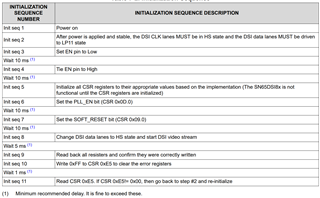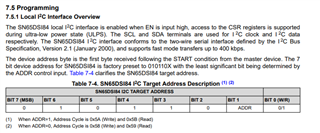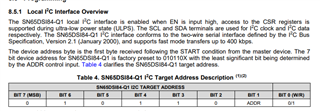Other Parts Discussed in Thread: SN65DSI83
Hello Team,
We are using TI SN65DSI84 Bridge chip on our custom board based on Renesas RZV2L processor. We are facing issue in detecting the bridge IC on I2C. Driver probing of SN65DSI8 fails with the below mentioned error.
We want to know do we need the initialisation sequence as mentioned in section '7.4.3 Initialization Sequence' of datasheet for the detection of bridge chip on I2C. Or is it for proper operation after the detection of bridge chip IC.
Could you let us know if the provided dtsi entry is proper. Please find attached file for dtsi entry of bridge chip along with panel entry and dsi node.
Also find the below mentioned error logs.
root@sm2s-rzv2l:~# dmesg | grep -i dsi
[ 2.012826] sn65dsi83: probe of 2-002d failed with error -22
Below is the output of i2cdetect command , there is no device detected on the address 0x2d.
root@sm2s-rzv2l:~#
root@sm2s-rzv2l:~# i2cdetect -y 2
0 1 2 3 4 5 6 7 8 9 a b c d e f
00: -- -- -- -- -- -- -- -- -- -- -- -- --
10: -- -- -- -- -- -- -- -- -- -- -- -- -- -- -- --
20: -- -- UU -- -- -- -- -- -- -- -- -- -- -- -- --
30: UU -- UU -- -- -- -- -- -- -- -- -- -- -- -- --
40: -- -- -- -- -- -- -- -- -- -- -- -- -- -- -- --
50: -- -- -- -- -- -- -- -- -- -- -- -- -- -- -- --
60: -- -- -- -- -- -- -- -- -- -- -- -- -- -- -- --
70: -- -- -- -- -- UU -- --
root@sm2s-rzv2l:~#
Can you help us for resolving the issue.
Thanks,
Nilesh






